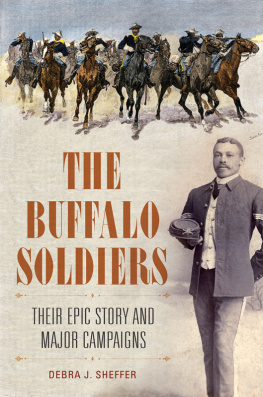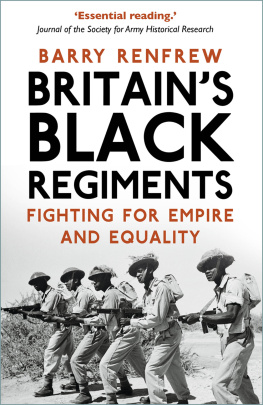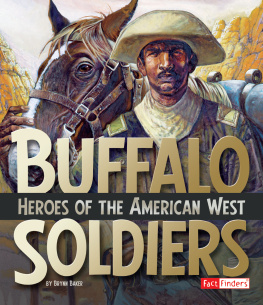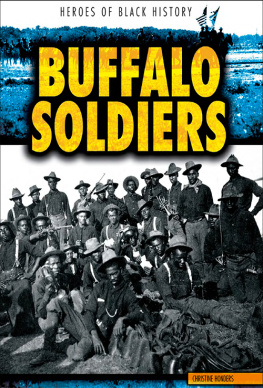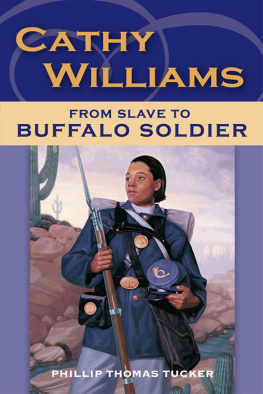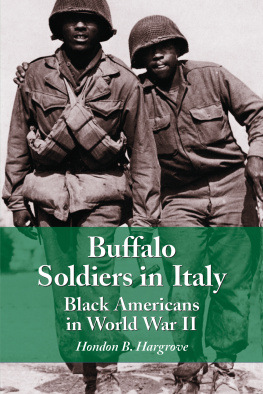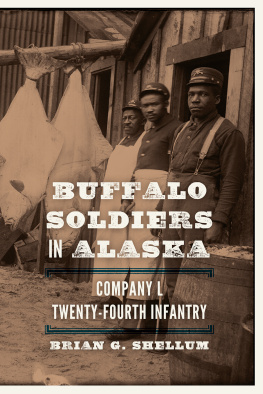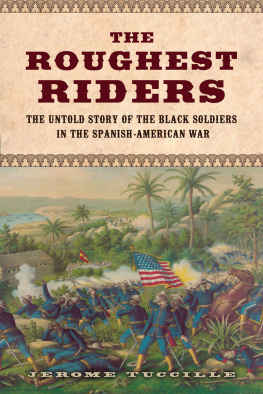The Buffalo Soldiers
The Buffalo Soldiers
Their Epic Story and Major Campaigns
Debra J. Sheffer

Copyright 2015 by Debra J. Sheffer
All rights reserved. No part of this publication may be reproduced, stored in a retrieval system, or transmitted, in any form or by any means, electronic, mechanical, photocopying, recording, or otherwise, except for the inclusion of brief quotations in a review, without prior permission in writing from the publisher.
Library of Congress Cataloging-in-Publication Data
Sheffer, Debra J.
The buffalo soldiers : their epic story and major campaigns / Debra J. Sheffer.
pages cm
Includes bibliographical references and index.
ISBN 978-1-4408-2982-6 (print : alk. paper) ISBN 978-1-4408-2983-3 (e-book) 1. African American soldiersHistory. 2. United StatesArmyAfrican American troopsHistory. I. Title.
E185.63.S47 2015
355.0089'96073dc23 2014044495
ISBN: 978-1-4408-2982-6
EISBN: 978-1-4408-2983-3
19 18 17 16 15 1 2 3 4 5
This book is also available on the World Wide Web as an eBook.
Visit www.abc-clio.com for details.
Praeger
An Imprint of ABC-CLIO, LLC
ABC-CLIO, LLC
130 Cremona Drive, P.O. Box 1911
Santa Barbara, California 93116-1911
This book is printed on acid-free paper 
Manufactured in the United States of America
This book is dedicated to my mother, Vera Creek.
Thank you, Mom.
Contents
I owe thanks to many people for completion of this work. I can never repay some of them, and this work is theirs as much as mine.
Theodore Wilson at the University of Kansas, without whom this book would not exist. I am so fortunate that he was my first and most important contact at KU. He was and still is my mentor.
Taylor Sheffer, for enduring my struggles and moments of madness. She sacrificed much of her time to the project.
John Jumara, for his unfailing confidence and supportand the occasional push to keep me working.
Park University provided a research grant which supported much of the research for the project.
My fellow B-Club members, John Curatola, Kevin Benson, and Candy Ruff. Your support helped me more than you know.
Dr. Ben Post, whose expertise guided and corrected my research and whose conversations informed my perceptions.
Mike Sheets for helping me understand the categories of discharge from the army.
Fellow members of the Society for Military History graciously spoke with me about various aspects of this project and steered me to valuable sources.
Steve Catalano at Praeger Press has been very helpful to me during this process.
Lastly, I, like many, owe the Buffalo Soldiers a debt. Getting to know them has been a pleasure and an honor.
M any very good books have the words Buffalo Soldiers in the title. Many focus on one regiment or on only cavalry or infantry. Others examine one time period or one war. William H. Leckies The Buffalo Soldiers: A Narrative of the Negro Cavalry in the West is still essential reading for anyone interested in these men. He tells much of the story of the Ninth and Tenth Cavalry Regiments. Arlen Fowlers The Black Infantry in the West, 18691891 is a must read for information about the Twenty-Fourth and Twenty-Fifth Infantry Regiments. Fowler includes chapters examining regimental chaplains and education, as well as information about Lieutenant John Bullis and the Black Seminole Scouts. In The Black Regulars, 18661898 , William A. Dobak and Thomas D. Philips examine the administrative and political aspects of the all-black regiments as part of the larger story of the lives and experiences of the soldiers from their enlistment after the Civil War to the Spanish-American War. Bruce A. Glasrud and Michael N. Searles edited Buffalo Soldiers in the West: A Black Soldiers Anthology , which provides a useful literature review and examination of a variety of topics, including the only known female buffalo soldier, who served in the Thirty-Eighth Infantry.
Regimental histories provide valuable information. Five helpful volumes include Edward L. N. Glasss The History of the Tenth Cavalry , William G. Mullers The Twenty-Fourth Infantry , Herschel V. Cashins Under Fire with the Tenth U.S. Cavalry , John Henry Nankivells History of the Twenty-Fifth Regiment , and L. Albert Scipio IIs Last of the Black Regulars: A History of the Twenty-Fourth Infantry Regiment . Works examining individual officers, such as Paul H. Carlsons Pecos Bill: A Military Biography of William R. Shafter and Leckies Unlikely Warriors: General Benjamin H. Grierson and His Family , contain information about the Buffalo Soldiers. Government documents and records provide a wealth of information, and many of these are now available in digital format or as reproductions. Newspaper articles and archival records contain details for a more complete story. These also are readily available in digital and print format. Few, if any, of these sources tell the whole story of the Buffalo Soldiers. In fact, no single book can tell the entire story of these men and regiments.
So, why another book about the Buffalo Soldiers when so many good ones exist? The year 2016 marks the 150th anniversary of the formation of the first six all-black regiments in the peacetime regular army, a milestone we should note. This book strives to tell the stories of all the Buffalo regiments, from their organization in 1866 through President Harry S. Trumans desegregation of the military in 1948. It endeavors to do something else that few others have, by examining the connections between those warriors known as the Buffalo Soldiers and those who served and sacrificed both before and after them. Though their service was excruciatingly isolated, the Buffalo Soldiers of the Indian War years did not serve in a vacuum. They built on the unrealized dreams of those who served before them, and they paved the way for those who followed. A larger historical context provides a more meaningful picture of the service of the Buffalo Soldiers, telling their story as part of black military service from the American Revolution to the Korean War, when desegregation ended the story of all-black units and the story of the Buffalo Soldiers.
Several themes surface in the story of these men. A major theme is their honest and faithful service. While not perfect, these men consistently served both honestly and faithfully. Like all soldiers, they broke rules and committed acts outside accepted boundaries. While the words honest and faithful service apply to many regiments, both white and black, these qualities are remarkable in the Buffalo Soldiers because of the particular problems they encountered at every turn, problems they sometimes overcame by their own efforts. Many lacked basic education as a result of years in slavery or lack of opportunity. Illiteracy made it impossible for them to fully function in their new roles as soldiers, especially as clerks and noncommissioned officers. A chaplain with each regiment provided basic education, and many of the men took advantage of the opportunity. Other difficulties were out of their control, the most persistent and most significant being racism. Throughout their decades of service, they experienced discrimination and racism from their officers, their white counterparts, the civilians they protected, the military, and governmental institutions including the office of the president. That they remained faithful and honest under such trying conditions speaks to their character.
What they most hoped for in return for honest and faithful service was equality and full citizenship. But they served without either, only hoping that their service would earn them those cherished goals that other Americans enjoyed and took for granted. They were denied and disappointed through many wars, but they did not give up. At times, they fought for freedom and equality for people in other countries, people they did not even know, when they did not enjoy those same rights at home. Racism and discrimination were indeed their toughest and most persistent foes. They were also the hurdles most out of their control.
Next page
